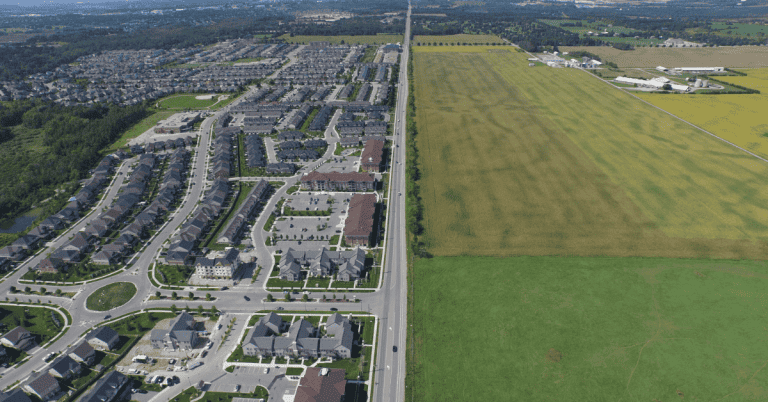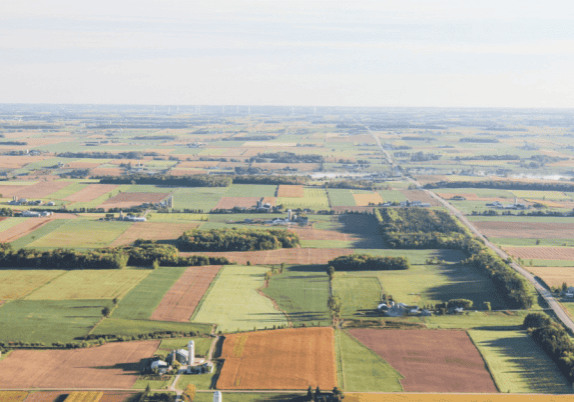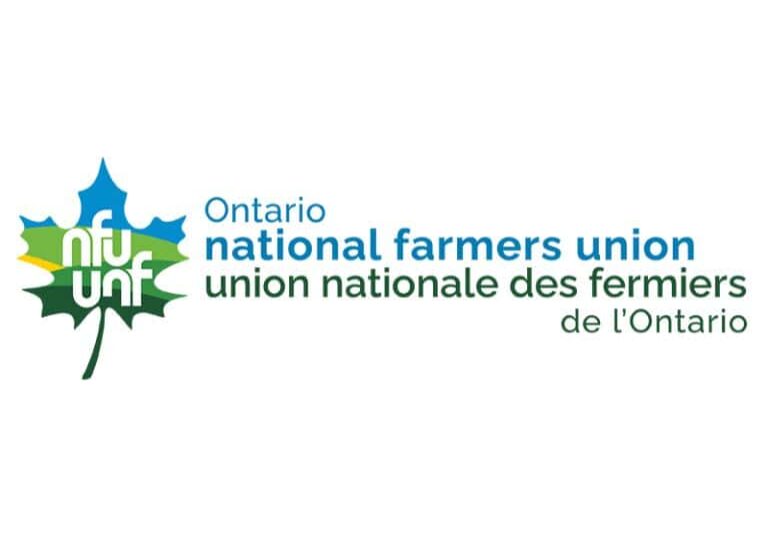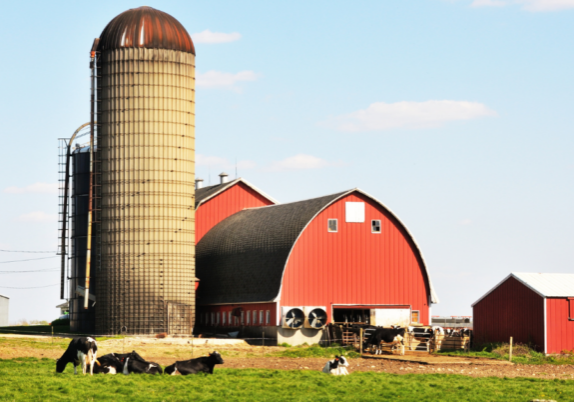The Problems with Bill 23 and the Proposal to Remove Lands from the Greenbelt

In late October and early November, the Ontario government announced two dramatic and fundamental changes to how we design and build our neighbourhoods and communities, and protect the environment in Ontario: Bill 23 (and related regulatory and policy changes) and a proposal to remove 7,400 acres of precious farmland and natural areas from the protected Greenbelt.
The Premier claims these changes would build more housing more quickly. He is wrong. The proposed changes would not solve the housing affordability and supply crises. Any new supply of truly affordable housing units would be offset by the loss of affordable units through redevelopment of existing rental housing for other uses. And the new supply of diverse housing types would not begin to meet the rising demand as our population increases. The government’s proposed changes would damage our existing neighbourhoods, towns and cities as well as the farmland and natural areas that sustain them, which in turn, would harm our ability to feed ourselves, protect ourselves from flooding, and address climate change risks.
This document presents an analysis of the impact these proposed changes, if implemented, would have on Ontarians. Taken together, the changes would:
– Do little or nothing to address the shortage of truly affordable housing
– Facilitate expensive urban sprawl and inappropriate high-rises at the expense of more diverse housing types designed for all stages of life and ranges of incomes
– Divert limited construction materials and labour away from building mixed and affordable
housing and direct them instead towards sprawl development, creating fragmented agricultural and natural landscapes
– Remove from the Greenbelt thousands of acres of valuable natural areas and agricultural land and turn them into sprawl development
– Undermine the protection of wetlands, woodlands, rivers, streams and wildlife habitat across Ontario
– Destroy key land use planning processes that Ontario municipalities, conservation authorities and residents need in order to protect, manage and plan for climate-resilient ecosystems and communities
– Create an ecologically vulnerable “Swiss cheese” Greenbelt by allowing land speculators to develop the lands that the government would have removed from Greenbelt protection.
The bottom line is that these proposed changes would bring chaos to land use planning in Ontario. The government claims its proposed actions would solve the housing crisis. But instead, the proposed changes will not enable affordable housing to be built where it is needed inside existing communities. The government is also eliminating key democratic processes and environmental protections to make it easier for developers to build what they want, where they want, and when they want, and forcing the rest of us to bear the financial, social and ecological costs.
Below we explain these matters in more detail, making it clear how we arrived at our conclusions.
The signatories to this document are from diverse sectors – agriculture, land use planning, liveable cities, environment, labour, healthcare and housing – and are coming together to speak with one voice. We do so because of the scale of the threats represented by the government’s attacks on planning and environmental protection inherent in their proposals. Together, we can chart a path that solves the housing crisis in a way that is affordable, ecologically sustainable, protective of agriculture and climate-friendly, thereby building a brighter future for Ontario.
Spokespeople:
– Anne Golden (former Chair, Task Force on the Future of the GTA)
– David Crombie (Friends of the Golden Horseshoe)
– Geordie Dent (Federation of Metro Tenants’ Association)
– Max Hansgen (President, National Farmers Union – Ontario)
– Margaret Prophet (Simcoe County Greenbelt Coalition)
– Tim Gray (Environmental Defence Canada).
For a full list of signatories, click here.
Analysis of Bill 23 and Related Regulatory Changes
Top-line Conclusions
These proposed changes would:
– Transfer very large amounts of taxpayer dollars from municipalities to for-profit developers while doing little to solve the housing crisis
– Restrict the ability of municipalities to build truly affordable housing
– Remove important planning laws and rules that are needed to constrain financially and environmentally unsustainable and damaging sprawl-type development being driven by land speculators
– Allow for hyper-intensification or ‘vertical sprawl’ in areas where municipalities had not planned for such high density, straining existing infrastructure and other public services and amenities
– Eliminate key environmental protections that are needed to stop flooding and protect wetlands, woodlands and wildlife in a time of growing climate change impacts and unprecedented biodiversity loss
– Restrict the ability of municipalities to require construction of more energy-efficient and climate-resilient housing and neighbourhoods that are truly liveable
– Undermine democracy by reducing public participation in planning matters and urban design, and eliminating the public’s right to appeal planning decisions
– Jeopardize local efforts to achieve the goal of increasing the affordable housing stock through the design of safe, walkable neighbourhoods
– Accelerate the current, untenable loss of 319 acres of farmland per day in Ontario at the very time when supply-chain disruptions and climate change underline the need to enhance local food security
– Create chaos through the elimination of regional planning, thereby hindering critical long-term coordination of planning and provision of services for housing, and hinder short to medium-term housing construction at the very time it is so desperately needed.
Detailed Analysis
How Bill 23 would reduce the supply of truly affordable housing:
– The bill would amend the Municipal Act and City of Toronto Act to enable the Minister to limit the ability of municipalities to require the replacement of rental housing lost through redevelopment projects. Municipalities typically require full replacement of affordable units in buildings undergoing redevelopment since these redevelopments are a leading cause of the loss of rental housing, particularly older affordable units. This proposal would reduce the ability of municipalities to ensure the replacement of affordable units and would likely lead to a loss of affordable units.
– The bill would amend a Planning Act regulation to limit Inclusionary Zoning (IZ) – which is >used to secure affordable housing units – to 5% of units in a project, restrict the time period for ensuring affordability of these units to 25 years, and dictate the depth of affordability of such units. This would take away the power of municipalities to require higher percentages (10-20%) and longer time periods – often 99 years, and set the definition of affordability. In short, this proposal would significantly reduce the number of affordable units that could be required as well as the time period for ensuring the units remain affordable while also preventing municipalities from determining the income of households that such units may serve.
– The bill would still require a zoning change for any exterior structural changes to a house for a 2nd or 3rd unit as well as 1 parking space for each unit. This significantly weakens the ability to allow new 2nd and 3rd units as of right.
– The bill would remove the ability to include housing services in development charges by-laws, thus creating the loss of a revenue stream for affordable housing.
How Bill 23 would supercharge urban sprawl and wound local democracy:
– The bill proposes to abolish 50 years of coordinated regional planning in Ontario’s Golden Horseshoe beginning with Durham, Halton, Peel, Waterloo and York Regions and the County of Simcoe. Regional planning is meant to prevent “patchwork” sprawl by coordinating infrastructure with growth management planning and the identification of regional agricultural and natural heritage systems. The bill would turn over planning entirely to 89 local municipalities which do not have the resources, expertise, spatial jurisdiction or control of sewer and water servicing, major roads and public transit.
– The bill also proposes to abolish the Growth Plan for the Greater Golden Horseshoe, which would remove critically important policies and metrics – plus natural heritage and agricultural systems – aimed at reducing urban sprawl and supporting complete communities and transit by directing growth inward and using land and infrastructure more efficiently. Along with the dissolution of regional planning, abolishing the Growth Plan would lead to a substantial increase in farmland loss and urban sprawl when planning authority is turned over solely to the 89 local municipalities.
– The bill would prohibit any resident appeals of development applications to the Ontario Land Tribunal. This means that only developers could appeal a council decision on their applications, making the tribunal a developers’-only forum. This wrongly removes residents’ democratic rights, is blatantly unfair, and flouts the public participation principles of the Planning Act.
– The bill would delete the requirement for a public meeting for a plan of subdivision, thus depriving residents and neighbouring landowners of a public forum in which to hear about a project and share their views.
– The bill would remove site plan control for buildings of 10 housing units or fewer. Things such as egress/ingress, parking, landscaping and waste management would not be overseen in any formal fashion and there would be no requirement for drawings to show residents/neighbouring landowners the design of a site.
How Bill 23 would undermine environmental protection:
– The bill would limit Conservation Authorities (CAs) to considering only flooding and other natural hazards. This would affect their role in watershed planning and management, which are core to climate change mitigation and adaptation, flood protection, biodiversity conservation and recreation.
– The bill would freeze CA fees to current rates – an effort to starve CAs of funds, further weakening their ability to effectively function.
– The bill would remove or weaken CA permitting functions with a view to turning permitting over to municipalities, with CAs only commenting. This is part of an effort, combined with the abolition of regional planning (see above), to turn most environmental matters over to local municipalities which do not have the resources, expertise or spatial jurisdiction to manage those responsibilities but are where development interests wield the most influence.
– The bill would reduce regulated areas around wetlands and watercourses, exempt certain activities from the need for a permit, and allow developers to appeal the failure to issue a permit within 90 days to the Ontario Land Tribunal – all of which further reduce the ability of CAs to fulfil their mandate.
– The bill would require CAs to identify lands they own or control that could be used for housing development. It is unknown what criteria may be applied or who would make such a determination. This would further reduce public open space land and negatively impact ecological values.
– A policy proposal announced with this bill would fundamentally overhaul Ontario’s Wetland Evaluation System to disallow “complexing” of wetlands. This would significantly reduce the number and extent of wetlands that would be deemed to be provincially significant and thus off-limits to development. Wetlands often occur in groupings of smaller, interconnected wetlands which, individually, would likely not qualify as provincially significant. The proposal would also eliminate the endangered species criterion, drastically diminishing the likelihood that a wetland would be found to be provincially significant and consequently protected from development.
– Along with Bill 23, the government proposes to introduce a policy for the “offsetting” of wetlands, woodlands and other natural features. This means that developers would b allowed to destroy such features if they recreate a wetland or woodland elsewhere or pay a fee. Such approaches have been proven to fail in other jurisdictions where they have been attempted and ignore the fact that wetlands typically occur where they do because of connections to the groundwater regime. In addition, replacing a 100-year-old woodland with newly planted trees will not replicate the ecological roles of the existing woodland.
– The bill would effectively undermine municipalities who currently use – or want to use -Green Development Standards to promote buildings’ emission reduction targets and other green infrastructure goals. More specifically, amendments would remove the statutory authority for many parts of the Toronto Green Building Standard and narrow its application considerably, making it almost impossible for the City of Toronto to meet its building emissions targets.
How Bill 23 would threaten farmers growing food on some of the most valuable and highest-quality agricultural land in the world:
– By abolishing the Growth Plan and eliminating regional planning, the bill would remove critically important policies and metrics – plus natural heritage and agricultural systems – that have been designed to reduce urban sprawl and support transit systems that direct growth inward, and that aim to use land and infrastructure efficiently. The bill, when coupled with the government’s plans to remove farmland from the Greenbelt, would substantially increase farmland loss to urban sprawl.
– Farmers would no longer be able to appeal development applications to the Ontario Land Tribunal even when these developments do not meet minimum distance separations, have the potential to increase flooding risks, and/or have other environmentally negative impacts on their land.
– By opening the door to development on farmland, Bill 23—alongside the proposal to remove lands from the Greenbelt (see below) — would have the effect of further increasing land prices that both existing and new farmers could ill afford, and place even more prime farmland under the ownership of speculators and developers.
– Bill 23, by rolling back and undermining the current protections of the Provincial Policy Statement under the Planning Act, would revisit lot creation policies that could allow for farmland severances to support retirement lots, residential infilling, and/or housing surpluses. Severing farm properties leads over the long term to development and the permanent loss of farmland.
How Bill 23 would undermine the building of climate- resilient, liveable and affordable neighbourhoods, towns and cities:
– By undermining the power of Conservation Authorities (see above), this bill would remove important measures that maintain the ecological infrastructure that reduces flooding and the impact of severe weather events.
– The bill would eliminate the power of municipalities to create Green Development Standards that ensure new development is climate-resilient.
– The bill would open the door to expensive sprawl development outside of existing communities, thereby increasing costs to municipalities and diverting limited construction resources from building liveable, affordable homes in existing built-up areas.
– The bill largely ignores the recommendations of the Province’s Housing Affordability Task Force, which pushed for an end to exclusionary zoning inside cities as a way to ensure more housing supply and greater affordability in a mix of housing types located close to public transit, existing sewer and water infrastructure, jobs and services.
How Bill 23 would take money out of taxpayers’ pockets and put it into the pockets of for-profit developers
– The bill would largely reduce development charges, community benefit charges and parkland requirements – including but not limited to affordable units. The reality is that we need more, not less, parkland. Moreover, there is no acknowledgement that these lost revenues would need to be made up by residents/businesses in the form of higher taxes or user fees such that it would simply be a shifting of costs and the principle that growth should pay for growth.
– The bill has no provisions to guarantee that any reduced costs to developers for building homes won’t simply be pocketed by developers, as they will continue to charge what the market will bear. The end result would be a massive transfer of money from the public realm to private-sector development interests.
Top-Line Conclusion:
There is no need to remove 7,400 acres of valuable farmland and natural areas from Greenbelt protection when 88,000 urban acres across the Greater Toronto and Hamilton Area (GTHA) are already primed for development.
Detailed Analysis
The housing crisis requires immediate action. Construction needs to start as soon as possible on lands that are close to where people already live, work and play. There is plenty of land available for development in existing urban areas already close to transit and urban services. Plus there are 88,000 acres within the Greater Toronto and Hamilton Area (GTHA) already designated and ready for development that can easily be incorporated into existing transit and urban services. In sum, there is more than enough land already available within urban boundaries to exceed long-range housing targets.
Yet the Ontario government wants to remove 7,400 acres of farmland and natural areas from the Greenbelt to make way for housing developments a long commute away from where the majority of residents live, work and play. This makes little sense when well over 10 times as much land is ready for the development of mixed housing in communities where people already live and will do nothing to foster climate resilience.
The climate crisis requires immediate action. Permanently protecting environmentally important land and agricultural land in Ontario is crucial to mitigating climate change, protecting sensitive ecosystems, and ensuring food security for Ontarians. Every acre of natural area protected provides a wealth of ecological services and benefits. Disruptions to food supply-chains, increased transportation expenses, crop failures in other parts of the world, and the need to limit our use of carbon-based fuels, require us to enhance our food security by increasing our access to sustainably-produced, locally-grown food.
The Greenbelt was created almost 20 years ago to help ensure natural areas and prime agricultural lands are permanently protected from sprawl development. The Greenbelt is part of a suite of laws designed to concentrate new housing development in places where people already live, work and play and close to existing transit and services.
The proposal to remove lands from the Greenbelt would do nothing to address the housing crisis and create liveable, affordable communities. But it would:
– destroy 7,400 acres of Greenbelt farmland and natural areas and the vital ecological benefits they provide;
– harm climate resilience by undermining the ecological integrity of the watersheds and natural systems in and around the Greenbelt;
– set a destructive precedent that Greenbelt-protected lands will be sacrificed when land speculators want to develop them, thereby creating an ecologically damaged “Swiss cheese” Greenbelt;
– exacerbate the practice of land speculators putting pressure on farmers within the Greenbelt to sell their valuable farmland, thereby reducing vital local food production;
– divert limited construction resources away from building homes where they are needed within existing urban boundaries to building expensive and environmentally damaging sprawl on what was once Greenbelt-protected land;
– build homes that would likely not be affordable, therefore doing nothing for those who need affordable housing now.
In summary, the proposal to unnecessarily remove 7,400 acres of land from Greenbelt protection means Premier Ford is prepared to break his long-held promise, first made in 2018, to never remove land from the Greenbelt to be rezoned for urban development, thereby enabling massive profits for land speculators. It would undermine the Greenbelt and do nothing to build affordable homes for people who need them the most in communities near existing transit, services and jobs. Instead, it would lead to large profits for land speculators and developers who want access to Greenbelt-protected land to build expensive homes in sprawl development.








